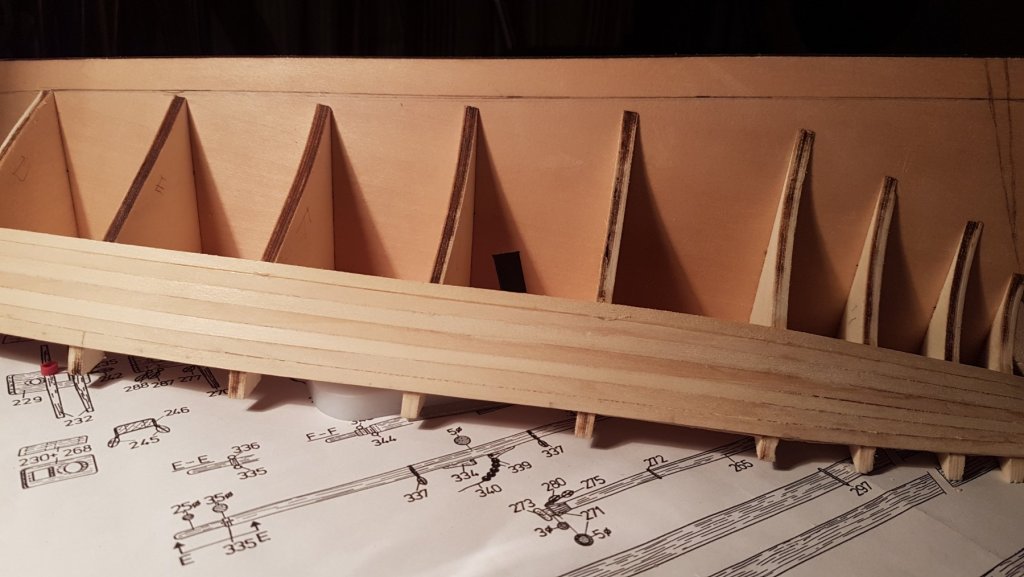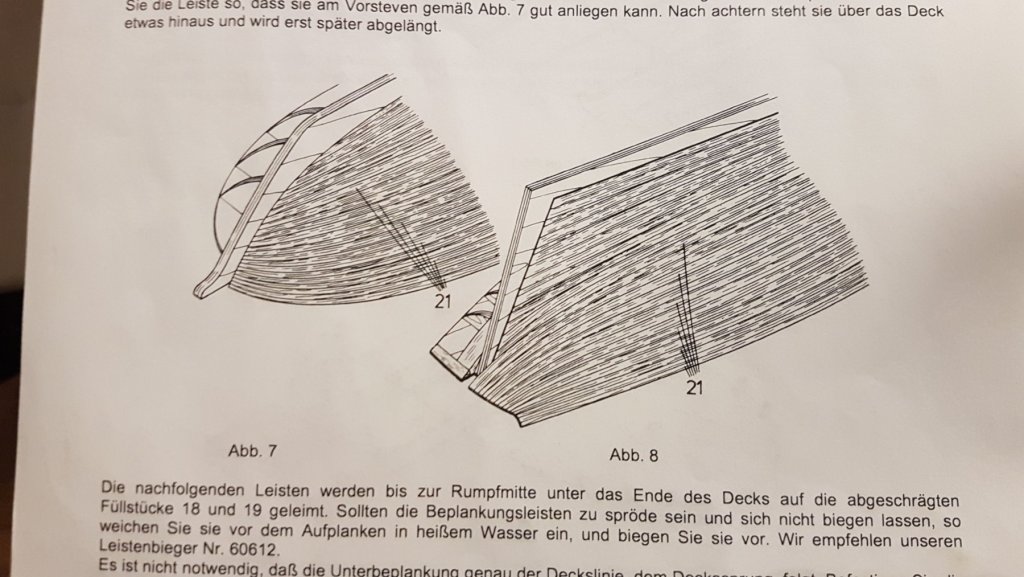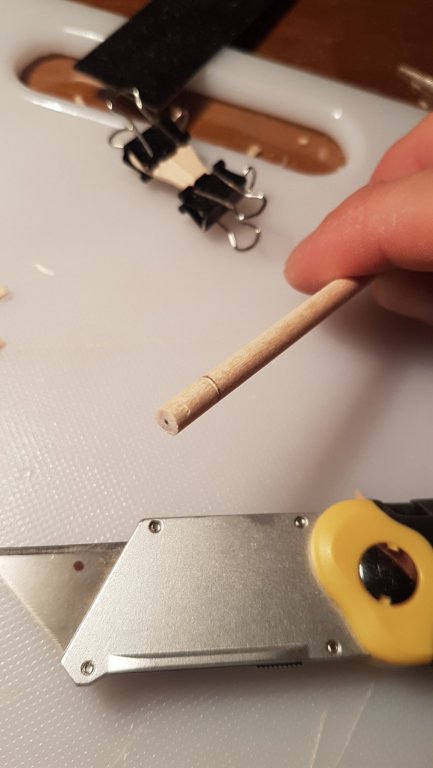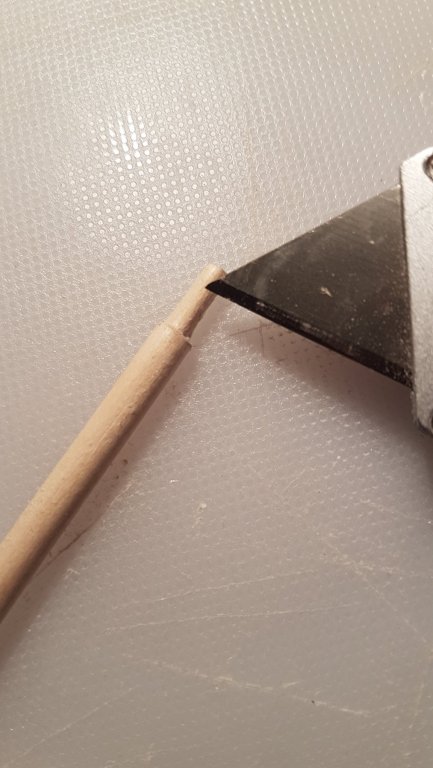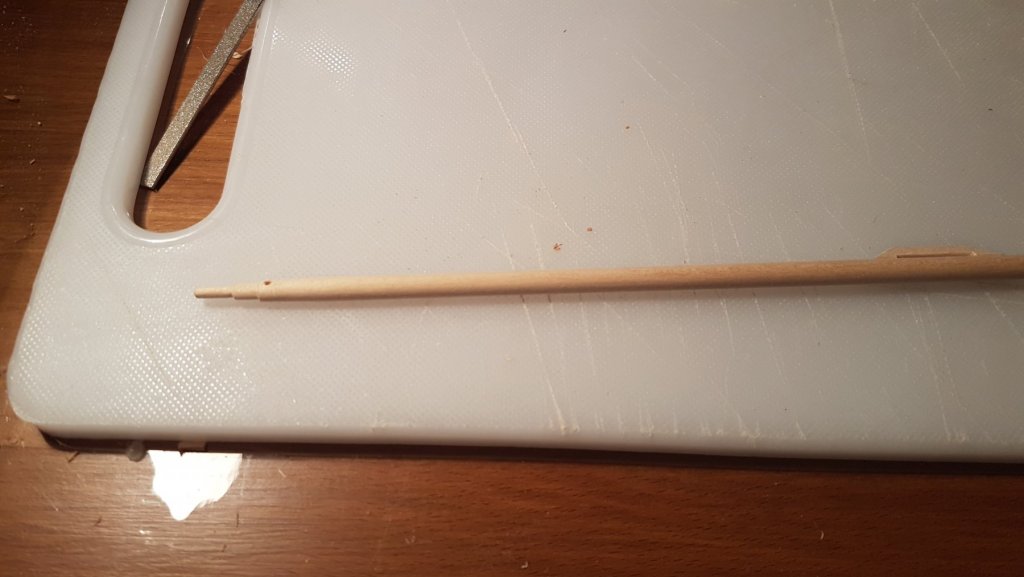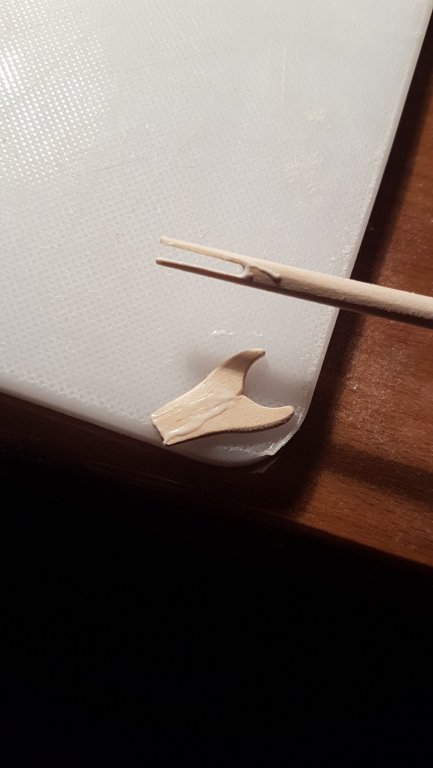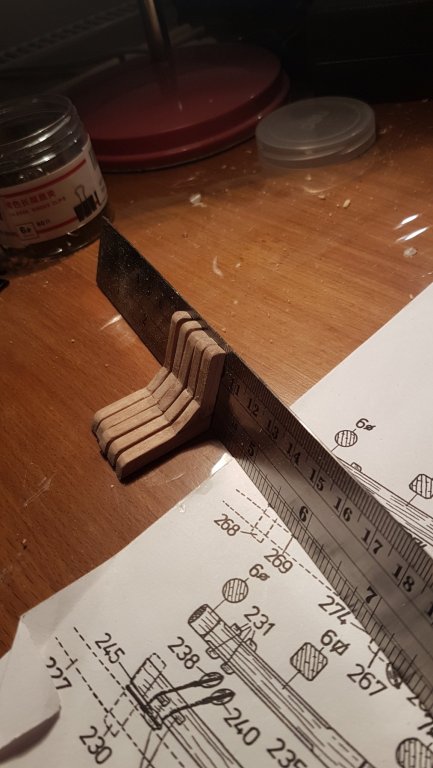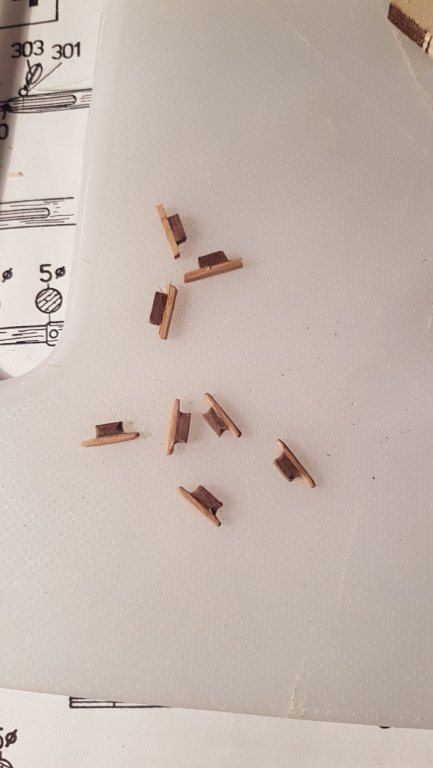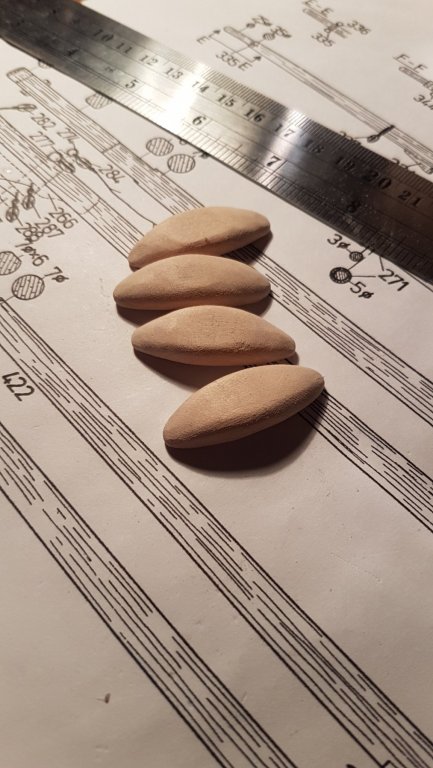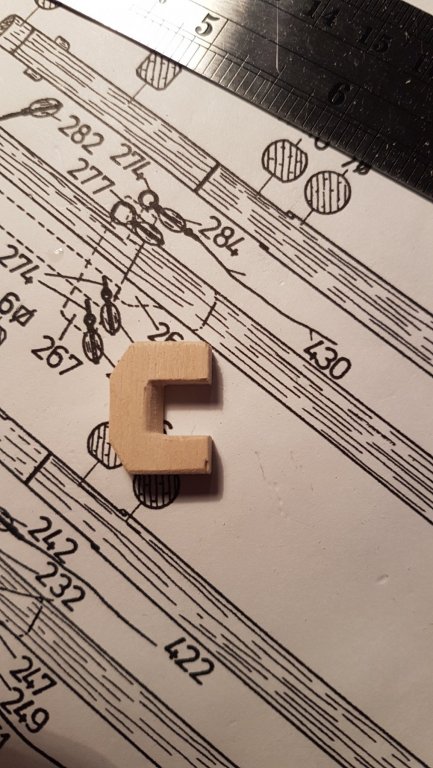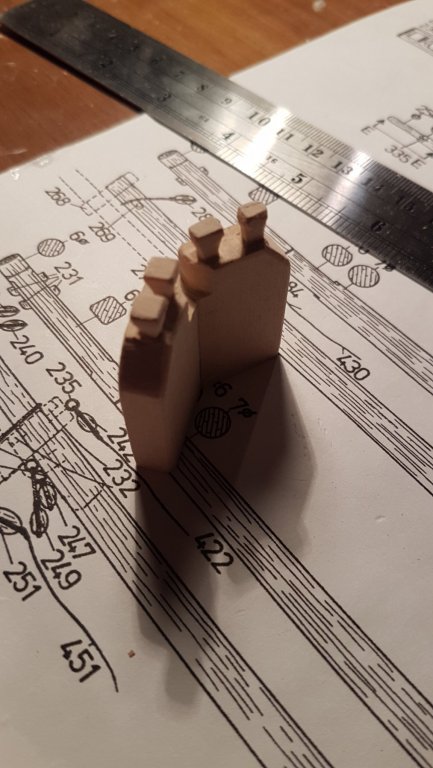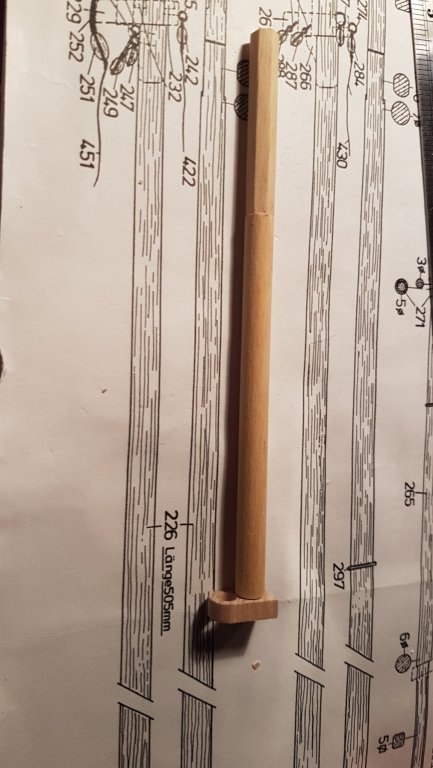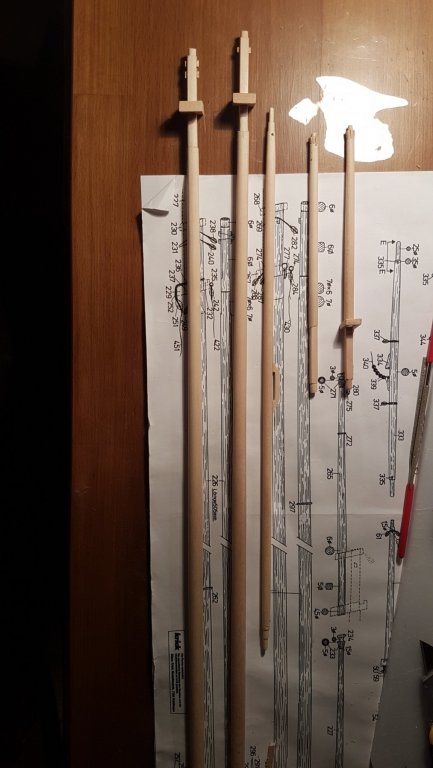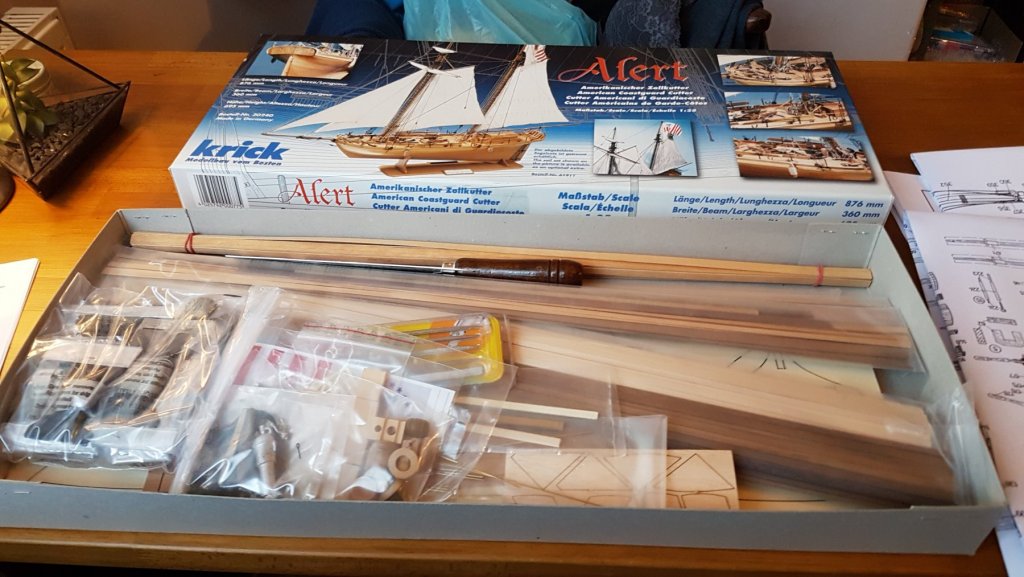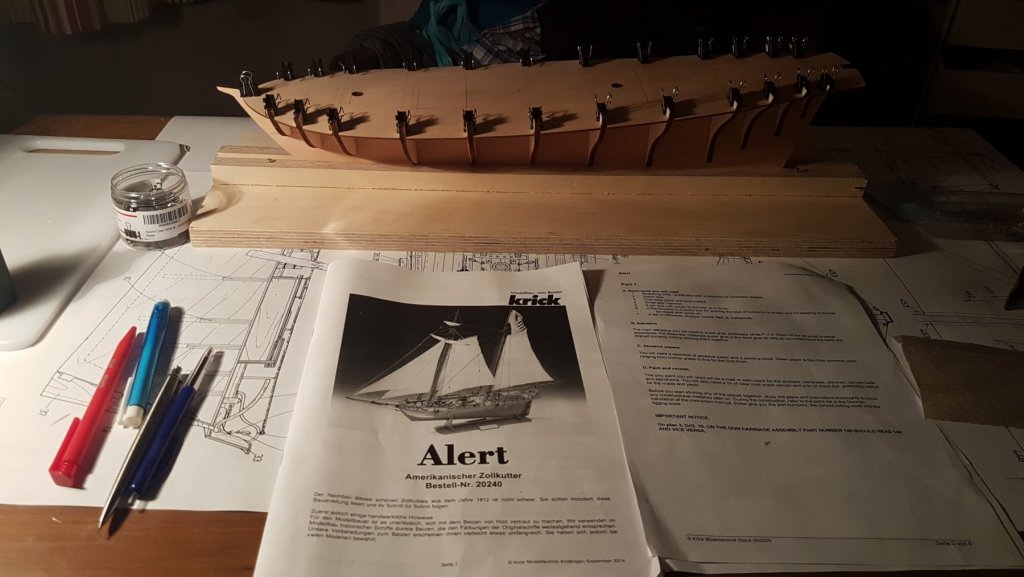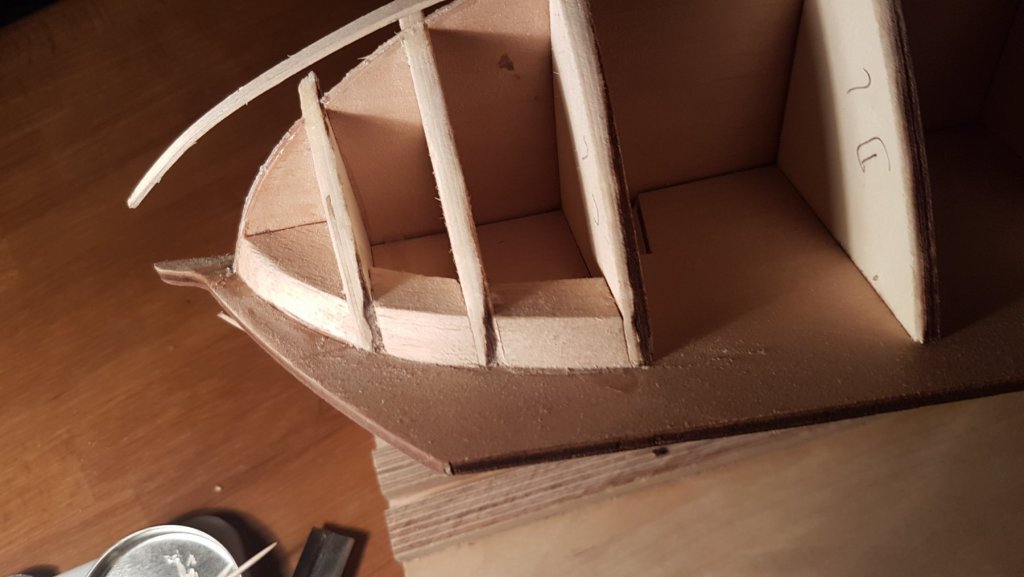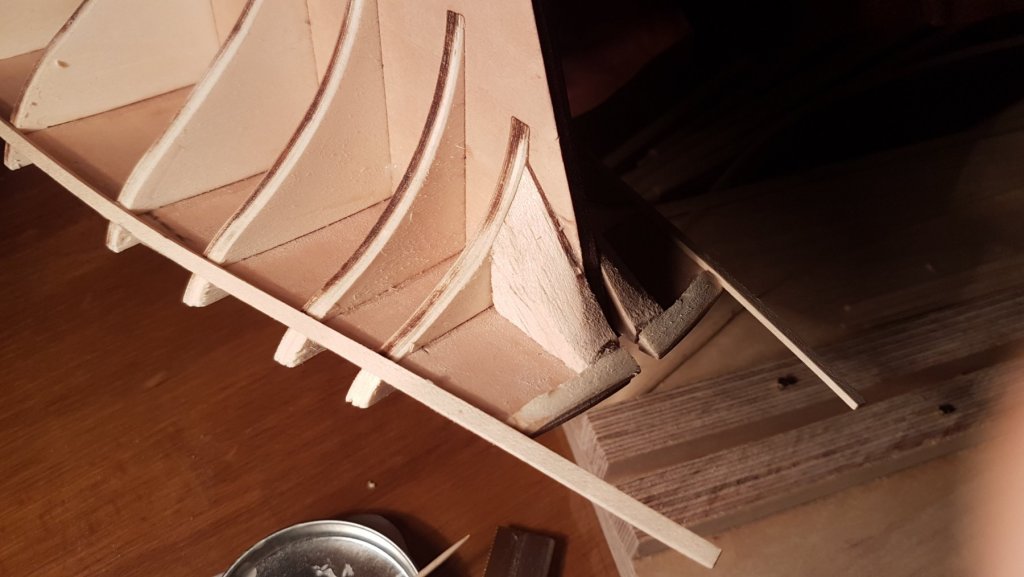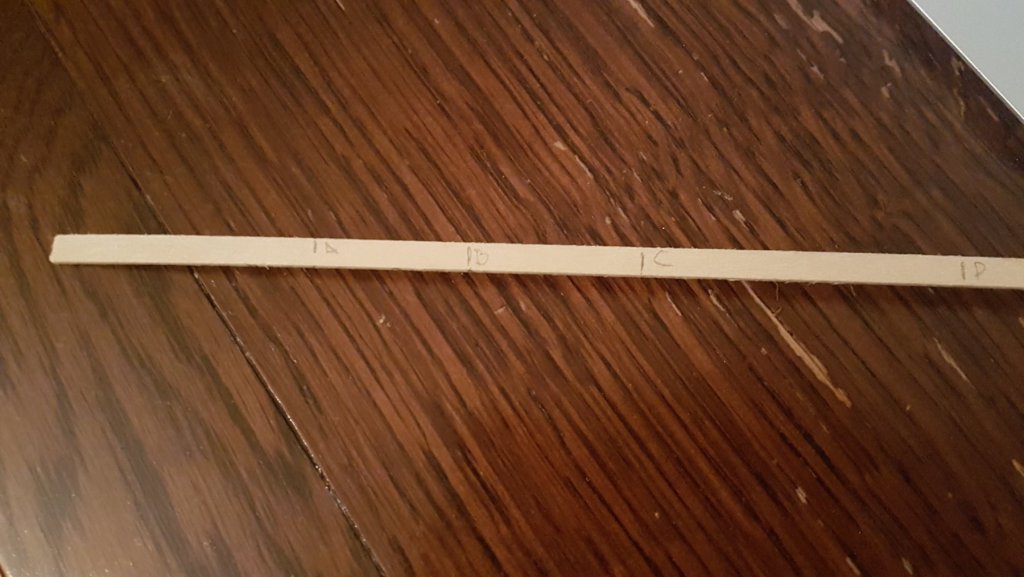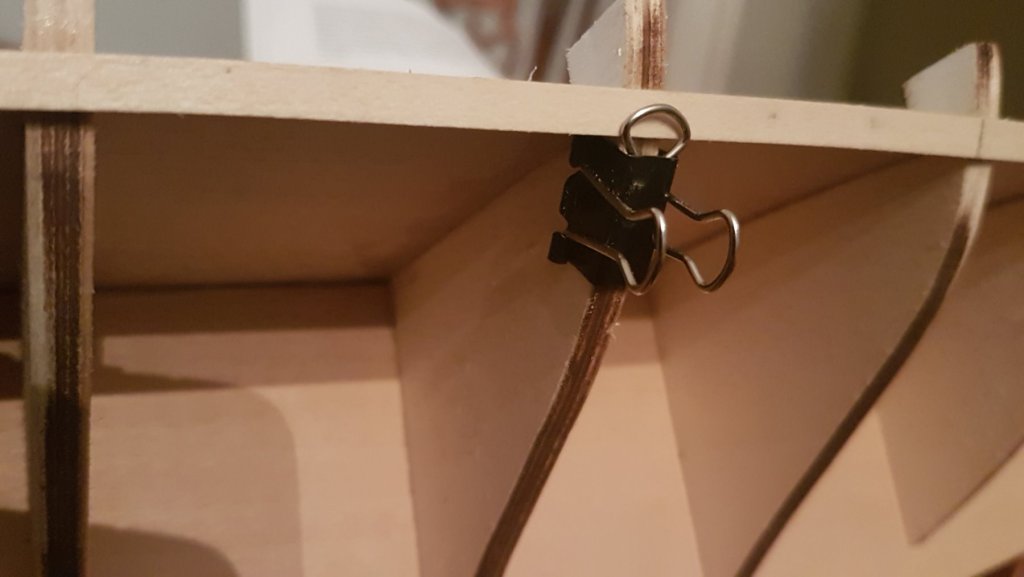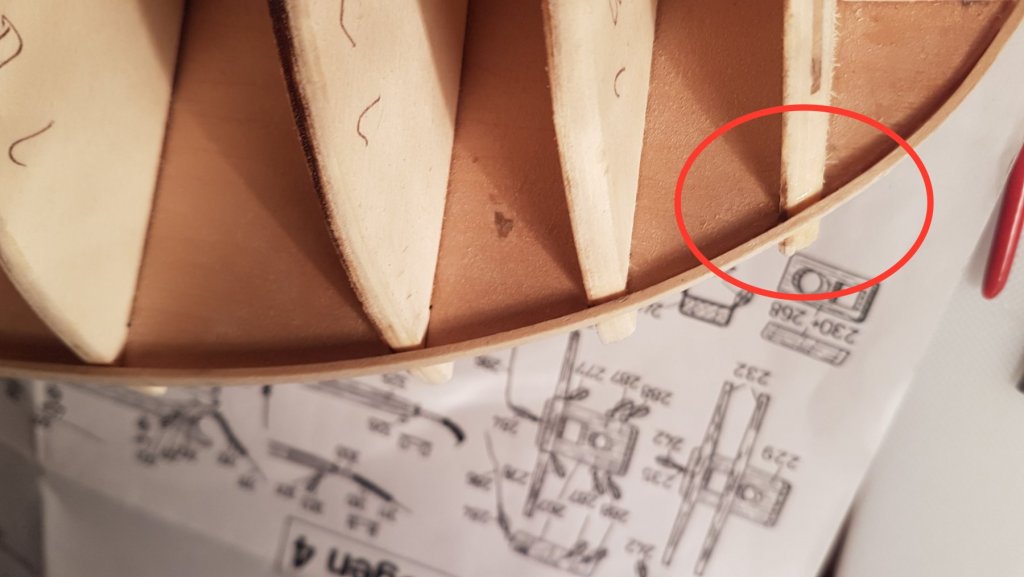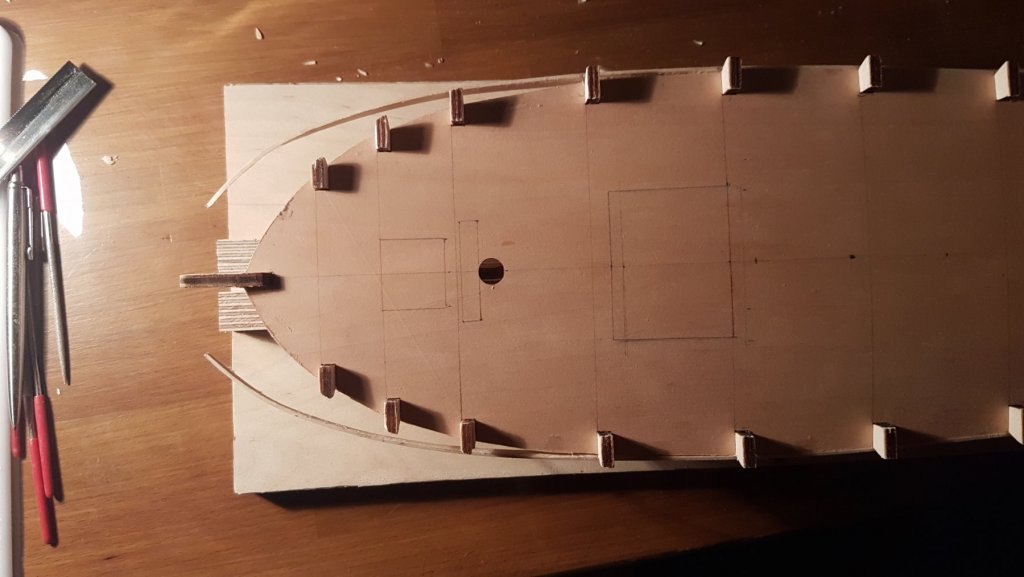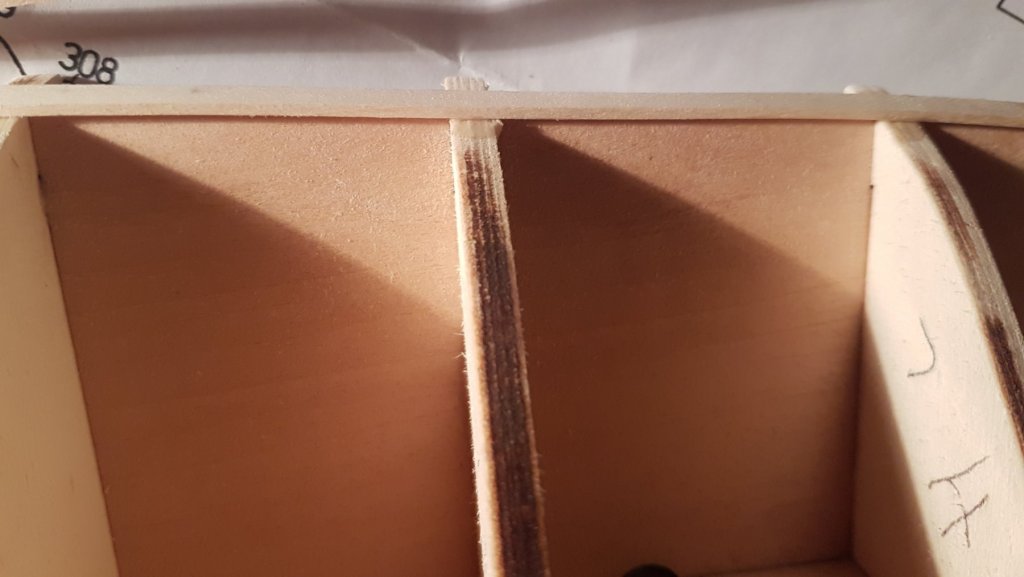
Daniel J
Members-
Posts
3 -
Joined
-
Last visited
Recent Profile Visitors
The recent visitors block is disabled and is not being shown to other users.
-
OK, so here goes another update: More Planking - Layer 1: So after I had put 2 planks on each side, and I was still a bit unsure if that was the way I should do it, I kept thinking, measuring and trying to visualize things, until I realised I had made another mistake :0. I had made the measurements to determine the width of the planks at each bulkhead from the deck to the end of the bulkheads, however, some of the planking, in particular in between bulkheads E through L, does not finish at the bulkhead but carries on the side of the keel. Therefore, I had to stop and remeasure: First I measured and drew on the keel, how far the planking was supposed to go down to. It is pretty much, 1cm parallel to the bottom of the keel from bulkhead D onwards. With this, I could measure to the line following the curve of each bulkhead. This gave me bulkhead J as the longest distance. I also determined that there were 6 filler planks, by looking at the different drawings, in the stern and that these pieces could only go up to and not past bulkhead I. I noticed that as I would plank on, the very Stern where the planks are attached to and L bulkhead will be covered and the end of the planks would continue attaching onto the keel (along the drawn line) and not the bulkhead. This meant that there would be less planks in the very stern and bulkhead L, and that the filler planks did not start until bulkhead L and the very stern were fully planked. After carefully looking at Abb 7 and 8, I determined that the total amount of planks at the bow was 23 and at the stern 29. This is because of the 6 filler planks to cover the greater distance around bulkheads K and J. After looking at the distances and the amount of planks, I determined that I could plank the whole boat with the need for only 1 filler plank instead of the 6 that the drawings have. This would mean I would have to plane less wood away, the planks would be stronger and more stable, and the shape and angle of the planning would be less steep and unnatural. Therefore, I decided to do: 11 Planks - Very Stern and Bulkhead L 24 Planks - Bulkheads K&J where 1 of the planks would be the filler plank going up to bulkhead I 23 Planks - Bulkhead B to I 20 Planks - Bulkhead A and very bow With these I could then divide the total distance of the bulkhead to the end of planking line by the amount of planks at that bulkhead and get the width of the planks at each bulkhead. You can't use the linear distance from bulkhead to bulkhead as this doesn't consider the radius and bend of the wood (which is particularly critical in the bow of the boat where there is the most curve). Therefore, using a dummy plank, I bent it around the bulkheads and marked out where each of the bulkheads was. I transferred those points to a new plank and then dotted the width at each point. I joined the dots, and as before, holding 2 planks together, one for each side, I planed down to the line. It seems to be working well and I'm on plank 8 now, although, I do feel I will have to do this measuring again before continuing to compensate from any deviations, of glue and setting the planks down. As I had mentioned I have been working parallel on a bunch of the other pieces of the boat as I find the planking the toughest and I need to invest quite a bit of time every time I work on it, which I don't always have. Here are a few of the bits I have worked on: Boom (324) & Gaffs (312 and 299): I've been working on the boom (324) and gaffs (312 and 299), as well as the supports for the sails Unterrah (341), Marsrah (333). WARNING! One thing that caught me out was that I also made piece 351 (Unterrah), but after looking where it goes on the boat I realized that it does not go anywhere and the wood used for it is needed somewhere else. So, Do Not Make Piece 351, Not sure why this is on the prints. Rope End of Boom and Gaffs: All these pieces required one or two small carved levels on their end. The way that worked best for me was to put a pencil dot in the very center of the diameter, then measure out, on the length, how long the carve had to be and drew a line around the circumference. I would then score with a blade the line (maybe 1mm deep), by pressing the blade and rolling the wood. Then (carefully) using the blade I carved towards the tip using the central dot I had made as a reference to make sure I was taking similar amount off each side and keeping it centered. It worked a bit like sharpening a pencil with a blade. Then I would carve backwards towards the scored line, and because it was already scored the small piece would come off. Repeat this as many times as necessary, sanding here and there as I saw fit, until I got to the needed diameter. Once these level carves were done I would sand and round off the ends. Then I would gradually reduce the thickness of the wood from the center of the piece by planing and sanding, being careful that the paner would not got into the already carved ends which were at the right size. This is how they are looking: Mast End of the Boom (325) and Gafs (300, 313): These are a bit trickier as they require you to make the base that holds them against the mast. These are made all from the same the 8x2mm Ramin white wood (does anyone know what wood is Ramin is in English?). I cut the pieces to length drew the shape on one, but carved and sanded two at the same time to create matching opposites. Glue those together until dry, then cut out the section from the Boom and Gafs to fit this piece in, stick and clamp till dry and then sanded them down to make a smoother finish. A neat little trick was, once dried, to take a round piece of wood of the size of the receiving end, wrap it in sandpaper and use that to smooth out the inner curve. Transform Support (31): These are made from the Walnut strip of 5x5x50. You need to cut and shape these. They are made of 3 pieces, on Bogen 3 you will find in the bottom left the detailed length, size and angle for these. I found it quite tough to get them all 6 to be at the same angle so when glueing, I used a ruler to push them all to right (and same angle). I cut the joining triangles straight and then once they were glued on and dry, I sanded them slightly curved as the prints suggests. Cleats (327, 328, 329, 290, 291, 292, 293, 294, 295, 296, 253, 254, 255, 256, 257, 258, 259, 260): These are made of two parts the base is from the walnut strip of 2x2mm, and the top is walnut (slightly lighter) 1x2mm. The top parts (290, etc.) are 10mm long and the base (296, etc.) are 5mm long. I glued these first (dam these are tiny), once dry I then using a flat and a round file shaped these to look like Cleats. Here the top are before and the bottom after: Fenders (473): These are made from the 4 blocks of 8x13x35mm. I used tracing paper to transfer the shape to all 4 faces of the block, and then sculpted away. Boy it was hard work to get the concave side into shape without chopping a finger off. Something I noticed was that as I was carving the wood was getting smooth and shiny, which made it tougher and the blade was slipping more easily. I decided to wet the blocks, and I wish I had done that for all of them. Wetting the blocks makes the wood softer to carve, and there is a bit more grip meaning the blade doesn't slip as much, and if it does, you are applying less strength to it so it is not as dangerous. These still need a bit of work, but I think the hardest part is done. Bowsprit Support (24): These are pretty easy to find pieces as well. The are the 2 x 8x25x40mm pieces. On Bogen 3 there is the detail of their size and angle. I cut the top bits to hold the ropes a bit smaller, but I would recommend cutting them of the thickness of the block and not reducing it. Bowsprit Holder (62) (Bugspriethalter): This is pretty straight forward and made from a piece of 5x15x20 which is quite specific and easy to find. Its detail is on Bogen 3. One thing to consider is that the inner arch has an angle, I think it is about 1mm from one side to the other but I think is something that might have to be adjusted once the Bowsprit is in place relative to the deck. Bowsprit Part Closest to Deck (47): This piece was a bit tricky as it has a Hexagonal shape towards the deck end. Just be extra careful on Bogen 4, with regards to which perspective you are looking at of the hexagon. Also, Bogen 4 does not have the detail of how small the tip needs to be to fit onto part 52 which supports the Bowsprit tip. Part 52 is premade, and I had to trim down the tip of the Bowsprit to 5-6mm to match the opening on it. I increased the opening of Part 52 as much as I could but it is small and there is not a lot of material to take off. Masts (264 & 226) & Top Masts (227 & 265): The most tricky part of making these is keeping them centered after planning. In order to know how much I was taking off and to make sure I was taking off in all sides equally I did the same as I mentioned above with putting a dot on the very center and using that as a reference. I would also pick a point length wise and roll the wood with a pencil on it so I would create a mark in the circumference, and I would do this in different points. When planning I would then see... where there were no marks I had planned, where there were I hadn't. I also used this method to control the gradual reduction towards the tip of them. I would first remove by planning the closest line to the tip; I would redraw the line and plane then the first two lines; I would redraw them and plane 3 lines; etc. which gave me a nice and gradual reduction, which I then sanded heavily to make it nice and smooth. Things to consider are, the supports that join the masts with the top masts are premade (229, 267), but are different to each other so keep an eye out for which goes where. Also, the holes into which the masts are supposed to go into are round whereas they should be square, so you have to square the whole of these pieces, to match the square section on the masts. The reductions, and conversion from cylindrical to cubic are at an angle so make sure you follow that so the supports fit nice and flush. I hope this update is useful to anyone making this in the future, and please let me know if you know of any tips or disastrous mistakes I'm making (especially with regards to the planking). Cheers.
-
 Elijah reacted to a post in a topic:
Alert by Daniel J - Krick - Scale 1:25 - American Revenue Cutter - First Model Build
Elijah reacted to a post in a topic:
Alert by Daniel J - Krick - Scale 1:25 - American Revenue Cutter - First Model Build
-
 JpR62 reacted to a post in a topic:
Alert by Daniel J - Krick - Scale 1:25 - American Revenue Cutter - First Model Build
JpR62 reacted to a post in a topic:
Alert by Daniel J - Krick - Scale 1:25 - American Revenue Cutter - First Model Build
-
 ccoyle reacted to a post in a topic:
Alert by Daniel J - Krick - Scale 1:25 - American Revenue Cutter - First Model Build
ccoyle reacted to a post in a topic:
Alert by Daniel J - Krick - Scale 1:25 - American Revenue Cutter - First Model Build
-
Hello all, So this is my first model boat build. I have some experience with traditional woodworking, but this is the first model I am attempting. I wanted to create this log to help other people who are thinking about getting started get an idea of what a first build entails, and what I will be going through. I will be trying things out, figuring out techniques, making mistakes and having to fix them, which I will (embarrassingly) try to post it all here. If any of you experienced builders have some tips on any of the things I have done or will have to do, your advice will be most welcomed. I got the Krick Alert from shipwrightshop.com, it has some vague 2 page instructions in English, but the detailed instructions are in German, so this should also help anyone building this model to identify parts, and sections of the manual. Also, I'm not the most technical or knowledgeable about the different parts of a boat, so please forgive me if I don't use the right terminology. Anyway, I'm pretty excited about this project and very quickly realised it is quite the challenge. Here it goes: This is the kit. I also ordered some files and a small saw with it and it all arrived very promptly. I would certainly recommend the guys at shipwrightshop.com, at least for people in the UK. The first thing I got started with was setting the bulkheads into the keel. Some of them were a bit to tight so I had to file down (very slightly) some of them for them to fit in tightly without having to hammer them in. After dry fitting, I applied some glue and set them in place. To ensure they would sit correctly, I dry fitted the precut deck while they dried. One bit of advice would be to number the bulkheads (A, B, C, etc) before attaching them, which will make it simpler later for the planking. I have seen some people placing supports between the bulkheads but these were so tight, and being held at the top by the deck, I didn't feel there was the need for this. Once the bulkheads where in place, I sanded the top of them to be nice and flush with the top of the keel. I then took some tracing paper and using plan Bogen 2, I traced some lines and some of the things that go on the deck to make positioning them later a bit easier. Then, I and glued the deck in place. To do this I used 1.5cm binder clips which worked great. I could press down the sides of the deck which lay slightly lower than the centre and hold it down by clipping these to the top bit of the bulkheads. Pick bellow. I originally thought to buy smaller binder clips, luckily they didn't have any smaller ones, because these are a great fit and anything smaller would not fit. I then planned the bits of the deck that were sticking out of past the bulkheads. The small D-Planed worked excellent for trimming the most of it and then I did some sanding to get it to the right spot and the deck to sit flush with the bulkheads. To bevel the bulkheads, I used one dummy plank. I bent it around the bulkheads to identify where and how much of a bevel I had to put into each one of the bulkheads. I thought of and tried different ways to do this more precisely but, being such small measurements and tight in between bulkheads, I decided to just do it by eye bit by bit until I would see the plank lay flush against the whole bulkhead. For the bigger angles I used as small D-plane and then a long piece of wood (about 20cm) with some 120grit sand paper around it which would allow me to sand a couple of bulkheads at a time keeping a rough angle of how the plank would sit. I then moved to a small piece of wood (~5cm) with the same sandpaper to do the more detailed and precise work on each bulkhead. With the deck dry and the bevels in the bulkheads, I placed the bow and stern blocks that receive the planks, and then again, using a plank as a guide, I drew the curve on them and the with a stanley knife and sandpaper I shaped these to match the curves between the bulkheads. These are the front ones, parts 15, 16, 17: and these are the rear ones, parts 18: For parts 19 in the rear, finding the piece of wood to use was quite tricky but it is a 1.5x5.160mm piece of very soft wood. The only piece of that type of porous soft wood in the whole kit. I cut parts 19 slightly longer (4 of them because you need to stack 2 on top of each other, on each side), then I wetted the two for the first layer for about 10min, dried them with a cloth and bent them to roughly the right shape. I applied glue and using the binder clips I bent and held in place the first layer. Once dry, I repeated with the second layer. Once the parts were dry, I trimmed them to size and did the same as with the stern blocks (part 18). I used a dummy plank to get the right shape and this time with a flat hand file, I filed the bevel to match the right angle. See Abb. 5 Following the rough English instructions, I started looking into the planking starting at deck level, and oh my... was that a learning curve. I had about a million questions of what to do, how to measure, how to hold the planks, how to determine the bevels of the planks, etc. Some of these questions I still haven't answered, but I will let you know as I progress. Not sure if this is the right way, but here is what I am doing: First using a small bendy wire, I measured the length of each bulkhead from the level of the deck to the very end of the bulkhead. I created a chart, with the bulkheads and their distances, and then divided the longest distance by a full width of the planks. Starting from the front I labeled the bulkheads A, B, C... bulkhead H has the longest distance of 100mm which divided by 5mm, which is the width of the planks, gave me 20 planks. I then divided all of the other distances by 20, which gave me the width of the plank at that bulkhead. I took a plank, marked the position horizontally of each bulkhead and then marked the width at each bulkhead and joined the dots. Here is a pic of the guide plank I used to mark the distance of the bulkheads: The bow and stern block attachments don't have a clear length as they progress downwards, so I just continued the line from the other bulkheads all the way to the bow and stern. I put the marked plank together with another one (to match on the other side) and using the small D-Plane, I planed the planks down to the line. I then modified the binder clips following something I saw on Youtube. (Sorry, I can't remember who's video this was but all the credit goes to you "Hero" as this would have been a nightmare without this tip.) Using the modified clips and clipping the first plank against the deck, I followed the deck line glueing the plank, leaving it 1mm longer in the bow and an the rest hanging out in the stern (as you can see a few pics back). I then sawed the front to match the angle with the keel and it fitted nicely. Here, I made my first big mistake: In the bow, I tried to keep the bevel of the plank flush with the deck, which looked quite nice from above. After it had dried, I realised that this had basically forced the plank away from the bulkheads and when placing the next plank there was a huge offset. Here is a pic of the gap: So, I had to take a blade and from underneath cut along the join of the deck and the plank for the first few bulkheads to release the plank and re-glue it allowing the bevel to shift with regards to the angle of the deck, but keeping the plank nice and flush against the bulkheads. Here is a pic of the plank removed: Here is a pic of the plank sitting nicely against the bevel of the bulkheads after re-glueing: In the stern, there was so much twist, that I had let the plank curve naturally as I laid it flush against the bulkheads so I did not have to correct this. I could see the planking being one of the biggest jobs of the boat and something that requires quite a lot of time each sitting. Therefore, I have started with some of the other parts of the boat that I can progress when I have shorter amounts of time. I will continue with some of this other work I have done, and keep updating how I get on. Happy building.
About us
Modelshipworld - Advancing Ship Modeling through Research
SSL Secured
Your security is important for us so this Website is SSL-Secured
NRG Mailing Address
Nautical Research Guild
237 South Lincoln Street
Westmont IL, 60559-1917
Model Ship World ® and the MSW logo are Registered Trademarks, and belong to the Nautical Research Guild (United States Patent and Trademark Office: No. 6,929,264 & No. 6,929,274, registered Dec. 20, 2022)
Helpful Links
About the NRG
If you enjoy building ship models that are historically accurate as well as beautiful, then The Nautical Research Guild (NRG) is just right for you.
The Guild is a non-profit educational organization whose mission is to “Advance Ship Modeling Through Research”. We provide support to our members in their efforts to raise the quality of their model ships.
The Nautical Research Guild has published our world-renowned quarterly magazine, The Nautical Research Journal, since 1955. The pages of the Journal are full of articles by accomplished ship modelers who show you how they create those exquisite details on their models, and by maritime historians who show you the correct details to build. The Journal is available in both print and digital editions. Go to the NRG web site (www.thenrg.org) to download a complimentary digital copy of the Journal. The NRG also publishes plan sets, books and compilations of back issues of the Journal and the former Ships in Scale and Model Ship Builder magazines.

